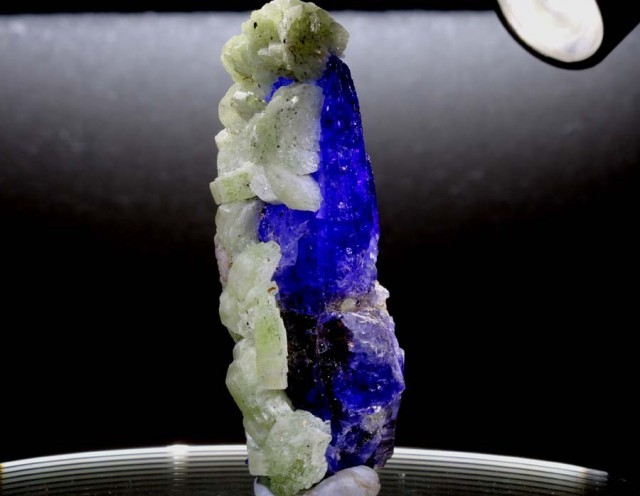35.75 CTS ALEXANDRITE ROUGH TANZANIA COLOUR CHANGE TBM-1125
- SKU
- Dimensiones (mm)
- 21.300 x 13.700 x 9.100mm
- Peso (cts)
- 35.750
- Treatment
- No Treatment
- Tipo
- Rough
- Colores
-
ALEXANDERITE ROUGH
BI-COLOUR
TANZANIA-MANGHOLA DUMAWANGA DISTRICT ARUSHA REGION
NICE GREEN CHANGES TO PURPLE
IDEAL FOR CABBING
TREATMENT-NONE
This rare gemstone is named after the Russian tsar Alexander II (1818-1881), the very first crystals having been discovered in April 1834 in the emerald mines near the River in the Urals. The discovery was made on the day the future tsar came of age. Although alexandrite is a relatively young gemstone, it certainly has a noble history. Since it shows both red and green, the principal colours of old Imperial Russia, it inevitably became the national stone of tsarist Russia.
Alexandrite is very scarce: this is due to its chemical composition. It is basically a chrysoberyl, a mineral consisting of colourless or yellow transparent chrysoberyl, chrysoberyl cat’s eye and colour-changing alexandrite (also in cat’s eye varieties). It differs from other chrysoberyls in that it not only contains iron and titanium, but also chromium as a major impurity. And it is this very element which accounts for the spectacular colour change. Rarely, vanadium may also play a part.
According to CIBJO nomenclature, only chrysoberyls displaying a distinct change of colour may be termed alexandrite.
- SKU
- Dimensiones (mm)
- 21.300 x 13.700 x 9.100 mm
- Peso (cts)
- 35.750
- Treatment
- No Treatment
- Tipo
- Rough
- Colores
-
ALEXANDERITE ROUGH
BI-COLOUR
TANZANIA-MANGHOLA DUMAWANGA DISTRICT ARUSHA REGION
NICE GREEN CHANGES TO PURPLE
IDEAL FOR CABBING
TREATMENT-NONE
This rare gemstone is named after the Russian tsar Alexander II (1818-1881), the very first crystals having been discovered in April 1834 in the emerald mines near the River in the Urals. The discovery was made on the day the future tsar came of age. Although alexandrite is a relatively young gemstone, it certainly has a noble history. Since it shows both red and green, the principal colours of old Imperial Russia, it inevitably became the national stone of tsarist Russia.
Alexandrite is very scarce: this is due to its chemical composition. It is basically a chrysoberyl, a mineral consisting of colourless or yellow transparent chrysoberyl, chrysoberyl cat’s eye and colour-changing alexandrite (also in cat’s eye varieties). It differs from other chrysoberyls in that it not only contains iron and titanium, but also chromium as a major impurity. And it is this very element which accounts for the spectacular colour change. Rarely, vanadium may also play a part.
According to CIBJO nomenclature, only chrysoberyls displaying a distinct change of colour may be termed alexandrite.
| Proveedor de envío | Envío a Australia | Envíos al resto del mundo |
|---|---|---|
| Standard Shipping - Tracked | $20.00 / 7 días días | $30.00 / 14 días días |
|
Australia
Standard Shipping - Tracked tiene descuento a $25.00 en pedidos con 2 o más artículos
Resto del mundo
Standard Shipping - Tracked tiene descuento a $30.00 en pedidos con 2 o más artículos
|
||
| FedEx | $40.00 / 3 días días | $40.00 / 7 días días |
|
Australia
FedEx tiene descuento a $40.00 en pedidos con 2 o más artículos
Resto del mundo
FedEx tiene descuento a $40.00 en pedidos con 2 o más artículos
|
||
| DHL | $30.00 / 2 días días | $30.00 / 21 días días |
|
Resto del mundo
DHL tiene descuento a $30.00 en pedidos con 2 o más artículos
|
||

rare large gemstones and minerals.
-
 Negativo
Negativounfortunately the colors in person under artificial or natural light look nothing like the ones posted on the listing. The stone appears very dark blue and it is hard to guess it is a parti sapphire.
-
 Positivo
PositivoAmazing stone!
-
 Positivo
PositivoLove it!
-
 Positivo
PositivoPaid and shipped - no feedback left after 100 days
















